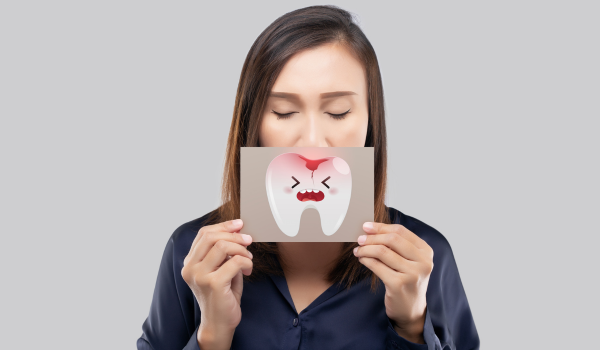.png)
Gingivitis is one of the most common gum diseases, and it is often the first step toward more severe forms of gum disease if left untreated. Early detection and treatment of gingivitis are crucial to maintaining good oral health and preventing further complications. Visiting a dentist for regular checkups and cleanings is essential for diagnosing and managing gingivitis. In this article, we will walk you through the diagnostic process for gingivitis, including clinical examinations, bleeding index checks, and diagnostic imaging techniques like X-rays.
1. The Initial Examination: What Happens During a Dental Visit?
When you visit the dentist for gingivitis diagnosis, the first step will be a thorough clinical examination. This allows the dentist to assess your overall oral health, identify signs of gingivitis, and determine the severity of the condition. Here's what you can expect during the initial exam:
-
Medical History Review: The dentist will ask about your medical history, including any existing conditions (such as diabetes) or lifestyle factors (such as smoking) that could affect your gum health. This information helps the dentist understand your risk factors for gingivitis.
-
Visual Examination of the Gums: The dentist will inspect your gums for signs of inflammation, redness, swelling, and bleeding. Healthy gums should be pink and firm, whereas inflamed gums will appear red and swollen.
-
Check for Plaque and Tartar: The dentist will examine your teeth and gums for plaque (a sticky film of bacteria) and tartar (hardened plaque), which contribute to gum irritation and inflammation.
This initial clinical examination provides essential information to determine if you have gingivitis and what level of intervention is required.
2. Measuring Bleeding on Probing: The Bleeding Index
One of the most common methods used by dentists to diagnose gingivitis is the measurement of bleeding on probing (BOP). This simple procedure helps to assess the level of gum inflammation. Here’s how it works:
-
Probing: The dentist uses a small, calibrated tool called a periodontal probe to gently press along the gumline between your teeth. This tool measures the depth of the gum pockets and checks for signs of inflammation.
-
Bleeding on Probing: If the gums are inflamed due to gingivitis, they will bleed when probed. The presence of bleeding upon gentle probing is a clear indicator of gingivitis.
-
Recording the Results: The dentist will record the amount of bleeding to determine the severity of the gingivitis. A higher frequency of bleeding can indicate more significant gum inflammation.
The bleeding index is an important diagnostic tool to gauge the extent of gum inflammation and is often used as a baseline for monitoring progress during treatment.
3. Checking for Gum Pocket Depth: Understanding Pocket Depth
In addition to probing for bleeding, the dentist will also measure the depth of the gum pockets. These pockets are spaces between the teeth and gums where plaque and bacteria can accumulate, leading to gum disease. Here's why pocket depth is important:
-
Healthy Gum Pockets: Healthy gums should have a pocket depth of about 1 to 3 millimeters. Any depth greater than this may indicate the presence of gum disease.
-
Shallow Pockets (Gingivitis): Shallow pockets of 3 to 4 millimeters can be indicative of mild gingivitis or early-stage gum disease. While these pockets may not be severe, they are still a sign that plaque and tartar are present and should be addressed.
-
Deep Pockets (Periodontitis): If the gum pockets are greater than 4 millimeters, it could indicate more severe gum disease, such as periodontitis, which is the next stage after gingivitis. If this occurs, further treatment may be necessary.
By measuring pocket depth, the dentist can assess whether the gingivitis has progressed to a more serious form of gum disease.
4. X-Rays: Assessing the Bone and Tissue Health
While a clinical examination and probing can provide valuable information about the gums, X-rays are often used to assess the condition of the bone structure beneath the gums. X-rays allow the dentist to detect hidden signs of gingivitis and other types of gum disease. Here’s why X-rays are useful:
-
Evaluating Bone Loss: In more advanced cases of gingivitis or periodontitis, the bacteria in the gums can attack the bone that supports your teeth. X-rays can help detect bone loss that may not be visible during a regular examination.
-
Identifying Tartar Build-Up Below the Gumline: X-rays can also reveal tartar buildup below the gumline, which is difficult to see with the naked eye but may be contributing to the gum irritation and inflammation associated with gingivitis.
-
Detecting Other Oral Health Issues: X-rays can help identify other oral health issues, such as cavities or abscesses, which can affect gum health and may be contributing to gingivitis.
X-rays provide a comprehensive view of your oral health, allowing the dentist to detect potential problems that are not immediately visible.
5. Diagnosing Mild vs. Severe Gingivitis
Once the dentist has gathered all the information from the clinical examination, probing, and X-rays, they will be able to diagnose the severity of your gingivitis. Gingivitis can range from mild to moderate or severe, depending on the extent of gum inflammation and damage. Here’s how the severity is determined:
-
Mild Gingivitis: Mild gingivitis is characterized by slight redness and swelling of the gums, along with occasional bleeding when brushing or flossing. There is usually no pain, and no significant damage has been done to the teeth or bone.
-
Moderate Gingivitis: Moderate gingivitis involves more pronounced swelling and redness, and the gums may bleed more frequently. Plaque and tartar buildup are more significant, and there may be some minor gum recession.
-
Severe Gingivitis: Severe gingivitis can lead to deep pockets, increased bleeding, and significant gum tissue damage. If left untreated, it may progress to periodontitis, which can result in tooth mobility and bone loss.
Based on the severity of gingivitis, the dentist will recommend the appropriate treatment, ranging from professional cleanings to more advanced periodontal treatments.
6. Treatment and Monitoring of Gingivitis
Once gingivitis is diagnosed, the dentist will recommend a treatment plan to reverse the condition and restore your gum health. Treatment for gingivitis typically involves:
-
Professional Cleanings: A thorough dental cleaning (scaling) to remove plaque and tartar from the teeth and gums. This is essential for eliminating the buildup that causes gingivitis.
-
Improved Oral Hygiene: The dentist will provide guidance on how to improve your oral hygiene habits, including proper brushing, flossing, and possibly using mouthwash to reduce bacteria in the mouth.
-
Follow-Up Appointments: After the initial treatment, regular checkups are necessary to monitor progress and ensure that the gingivitis is under control.
If gingivitis has progressed to periodontitis, additional treatments, such as root planing, deep cleanings, or surgery, may be required to restore gum health.
.png)
.png)
.png)
.png)
.png)
.png)
.png)
.png)
.png)



